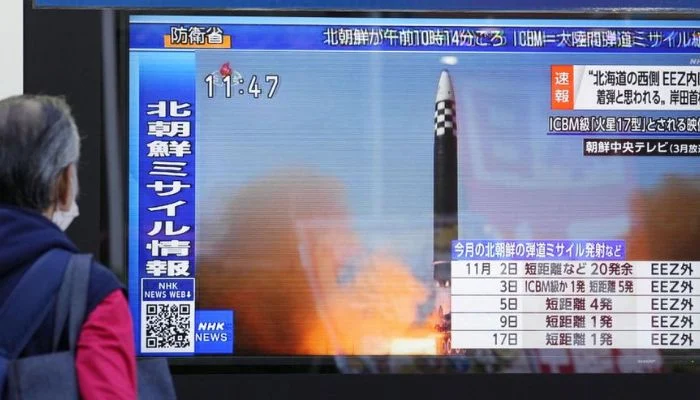SEOUL/TOKYO: North Korea fired a suspected intercontinental ballistic missile (ICBM) on Friday that Japanese officials said had sufficient range to reach the mainland of the United States and that landed just 200 kilometres (130 miles) off Japan.
The launch, reported by both South Korean and Japanese officials, comes a day after a smaller missile launch by the North and its warning of “fiercer military responses” to the US boosting its regional security presence.
US Vice President Kamala Harris will meet leaders of Japan, South Korea, Canada, Australia and New Zealand on the sidelines of the Asia-Pacific Economic Cooperation (APEC) summit on Friday to discuss the launch, a White House official said.
Harris is in Thailand for the APEC summit, amid heightened geopolitical tensions over the war in Ukraine and other flashpoints such as Taiwan and the Korean peninsula.
Friday’s launch adds to a record-breaking year for North Korea’s missile programme, after it resumed testing ICBMs for the first time since 2017 and broke its self-imposed moratorium on long-range launches as denuclearisation talks stalled.
Japanese Defence Minister Yasukazu Hamada told reporters on Friday that the missile was capable of flying as far as 15,000 km, while Chief Cabinet Secretary Hirokazu Matsuno said it flew to an altitude of about 6,000 km with a range of 1,000 km, before landing in the sea roughly 200 kilometres west of Oshima-Oshima Island in Hokkaido.
South Korea’s military projected the missile reached an altitude of 6,100 km and flew 1,000 km at a maximum speed of Mach 22.
North Korea often conducts its tests on such “lofted” trajectories where the missile flies much higher into space but to a shorter distance than it would if fired on a normal trajectory.
Misawa Airbase, which hosts both Japanese and US troops, briefly issued an order to seek cover, according to a post on the base’s Facebook page.
Military drills
Japanese Prime Minister Fumio Kishida said there had been no reports of damage but the North’s repeated missile launches could not be tolerated.
South Korean President Yoon Suk-yeol condemned the launch and called for stronger defence readiness and security cooperation with the United States and Japan.
North Korea’s last suspected ICBM test was on Nov. 3, when it fired multiple missiles into the sea in what it said was a protest against allied military drills by South Korea and the United States.
Friday’s launch would be the eighth ICBM test this year by North Korea, based on a tally from the US State Department.
ICBMs are North Korea’s longest-range weapon and are designed to carry a nuclear warhead as far as any location in the continental United States.
One day earlier, North Korea fired a short-range ballistic missile while its foreign minister, Choe Son Hui, warned of “fiercer military responses” to US moves to boost its military presence, saying Washington was taking a “gamble it will regret”.
In a statement carried by state media, Choe condemned a Sunday trilateral summit of the United States, South Korea and Japan during which those countries’ leaders criticised Pyongyang’s weapons tests and pledged greater security cooperation.
During that meeting, US President Joe Biden reaffirmed to Yoon and Kishida a commitment to reinforce extended deterrence and defend the two Asian allies with a “full range of capabilities”, including nuclear weapons.
Yoon, at a National Security Council meeting following Friday’s launch, called for additional sanctions against the North and measures to put extended deterrence in place, although he gave no specifics.
Long-range missiles
“Pyongyang is trying to disrupt international cooperation against it by escalating military tensions and suggesting it has the capability of holding American cities at risk of nuclear attack,” said Leif-Eric Easley, a professor at Ewha University in Seoul.
Concern has also mounted over the possibility of North Korea conducting a nuclear test for the first time since 2017.
South Korean and US officials have said the North has completed preparations for such a test, expected to be underground and possibly using a smaller nuclear device designed for tactical use.
North Korea’s ballistic missile tests are banned by United Nations Security Council resolutions that have sanctioned the country over its missile and nuclear weapons programmes.
South Korean and US officials have reported that a number of North Korean ICBM tests appeared to have failed this year, including a Nov. 3 test that appeared to have failed at high altitude.
North Korea on March 24 launched its biggest ICBM ever, which flew 67.5 minutes and reached an altitude of 6,248.5 km (3,905 miles), according to state media.
The North has also fired hundreds of artillery shells into the sea recently as South Korea and the United States staged exercises, some of which involved Japan.

